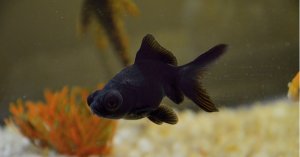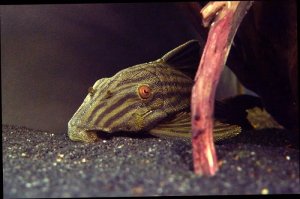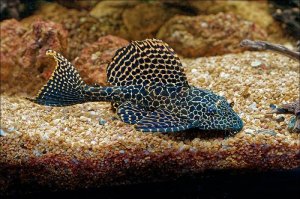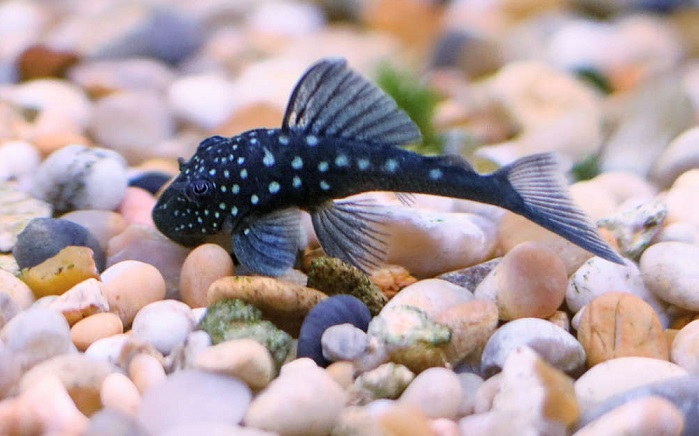
The Blue Phantom Pleco is a fabulous color variation of the Green Phantom Pleco that has deep dark blue colors and white spots resembling the dark blue night sky, with white stars. It looks truly remarkable when accompanied by the right background colors in your tank.Furthermore, it is an easy and adaptable Pleco species to take care of that will not grow excessively large, so you can get away with a 20-30 gallon tank and other tank companions of different species.The Phantom Pleco is easy enough to keep, though fairly impossible to breed, and prefers being on its own, being protective of its territory.
As a nocturnal species, you may only be able to enjoy seeing them at night, as they are rather shy. If you are interested in the Phantom Blue Pleco, then read on for a bit more about the species and its care requirements.
Blue Phantom Pleco Breed Overview
| Origin | South America |
| Lifespan | 5 – 8 years |
| Size | 7 inches (17.8 cm) |
| Colors | Blue and Green |
| Food | Algae Eater |
| Tank Size | 20 – 30 Gallons |
| Temperament | Placid, Nocturnal, Territorial |
| Water Temperature | 22 -25 °C (71.6-77°F) |
| Water pH | 0 – 7.8 |
| Difficulty Level | Intermediate to easy. Hard to Breed |
Species Summary
Very similar to the “Hemiancistrus subviridis”, or the Green Phantom Pleco, in layman’s terms, the Blue Phantom Pleco is essentially a color morph of the Green Phantom Pleco species. In General, the Phantom Pleco is an armored catfish species from the Loricariidae family, native to the Orinoco and Casiquire basins in Venezuela.
As the species is from the Loricariidae family it is rendered the letter “L” in its description, the Blue Phantom Pleco is (L128) whereas the Green Phantom Pleco is (L200). You may see a reference to the numbers throughout the article.
Color Variations
As mentioned the Blue Phantom Pleco is only a Color Variation or morph of the original Green Phantom Pleco. The Blue Phantom Pleco is described to have a very dark, almost cobalt blue to black colored body that is covered with striking white spots. The fins have a more translucent appearance, and they are similarly adorned with white spots.
Many times the Blue Phantom Pleco, also known as the Ice Blue Pleco may be confused with the Gold Nugget Pleco (L018), a different species of catfish with a similar shaped body, but a much smaller size and more distinctive spots.
Plecos have hard armor-like plates on their body, and softer skin on their tummies, rather than scales. They likewise can slightly change their colors to blend in with their surroundings, as a form of camouflage.
Male And Female Differences
Male and Female Phantom Plecos are quite hard to tell the difference especially when they are still young, though you can look for the following signs
- From a side angle, the female will be taller and bulkier than the male.
- Odontodes (hard teeth-like structures) are longer in the gills of males than females.
- On the pectoral fins, the odontodes are more developed in adult males.
- Females have a smoother hind body area, while males will have rows of odontodes.
The Papilla ( a small fleshy tube behind the anus) on the bottom of the fish is the best way to tell the sex of your Pleco. For males, they will be small and pointy, and for females, they will be round and broad.
Blue Phantom Pleco Color Variations
So as we have established, the Green Phantom Pleco (l200) is the original color. It has a light green body, with distinct yellow spots. The Blue Phantom Pleco can differ slightly from a very dark almost black blue to a lighter blue with prominent white spots.
These are the only color variants in the specific Hemiancistrus subviridis, though the Gold Nugget Pleco may look similar, it is not the same species or size.
Blue Phantom Pleco Size And Lifespan
- Size – You will notice that Phantom Plecos are normally sold when they are around 3 to 5 inches in size (7.6cm – 12.7cm), they will reach 7 inches (17.8 cm) when mature, though there have been cases where they have grown up to 8 inches (20.3 cm). Thus your Blue Phantom Pleco is a relatively large fish.
- Lifespan – Most Plecos, the Blue Phantom included, grow slowly, around one inch every year in the wild, maybe slightly slower in captivity where the conditions are not ideal. In captivity, they have a general lifespan of between 5-8 years, though according to specialist aquarists that they have kept them for up to 15 years in captivity.
Temperament And Behavior
Most Plecos, in general, are peaceful and shy when they are young, though they become territorial and aggressive, especially towards males, and only towards their species when they mature.
They are perfect in any community tank with other species, except with their own, so it is advisable to keep only one. They are similarly impossible to breed in captivity thus far, so getting a male and a female will also not be suitable.
General Care
Most Pleco Species are quite hardy, the Phantom Pleco being slightly more sensitive to abrupt water condition changes. Mostly, they can adapt to most water conditions, yet they need to be introduced slowly and do not cope very well with sudden changes in water temperatures, and pH levels.
Other than that they will do well in a well-planted large tank, with some driftwood, and they have mainly a herbivorous diet.
So, let’s go through the basics of their care:
Setting Up Your Aquarium
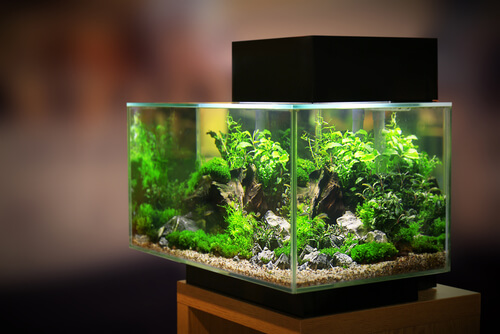
When creating a living space for any aquatic animal, it is always best to start with consideration of their natural habitat. The Phantom Pleco originates from water basins and rivers in Venezuela that are fast flowing, sandy, and have dense vegetation.
They need a diet rich in algae, and plenty of hiding spaces, and enjoy shade more than direct light. They are fairly adaptable to clear murky waters and even floodplains in the rainy season, and they will need some driftwood to aid in digestion.
- Tank Size – The Minimum tank size for a single pleco is 10 Gallons, though 20-30 gallons with other species tank mates is more acceptable.
- Water Conditions –They prefer slightly acidic and softer water though they will do well within a ph range of between 6.0 and 7.8ph. They are tropical fish requiring warmer waters of around 22 – 25 °C (71.6-77°F). It’s important to try and keep a stable temperature for proper oxygen intake for them.
- Filtration – The Phantom Pleco enjoys moderate currents and clean water, thus a high-flow filter will be required that is suitable for the size of your tank.
- Light – Most Pleco species enjoy more shade than light, though some light may be needed for plant growth. You can opt for some indirect sunlight or low artificial light.
- Heat – As Plecos do require warm water and a very constant water temperature most aquarists highly recommend a reliable heater and thermostat.
Decorating Your Tank
One important factor when decorating your Plecos tank is that they require many hiding spots, and they are nocturnal, thus you can choose from options of a sandy substrate tank with rocks and driftwood, or a very lush planted tank with some hiding spots, they do not essentially require plants.
- Substrate – Blue Phantom Plecos have soft bellies, and they are bottom-dwelling fish, thus you want a very soft and fine sandy or gravel substrate for them with a few small rocks.
- Ornaments and Toys – Rocks, caves, and Driftwood are your ideal ornaments, as they mainly need hiding spots, and will feed algae and other small organisms from the driftwood.
- Live Plants – Live Plants are optional, though they are advised for shade and a more natural environment. Long-stemmed plants and floating plants are ideal. You can use the following:
- Anubias
- Amazon sword
- Vallisneria
- Java Ferns
- Floating Amazon Frogbit
- Java Moss
- Cryptocoryne wendtii
- Driftwood – Most Pleco species need Driftwood for feeding, and to add fiber to their diet, and they enjoy the hiding space it provides. A few good driftwood choices are:
- Malaysian Blackwood
- Spider driftwood
- Mopani driftwood
- Cholla driftwood
- Saba Wood
- Bogwood
Introducing And Choosing Your Blue Phantom Pleco
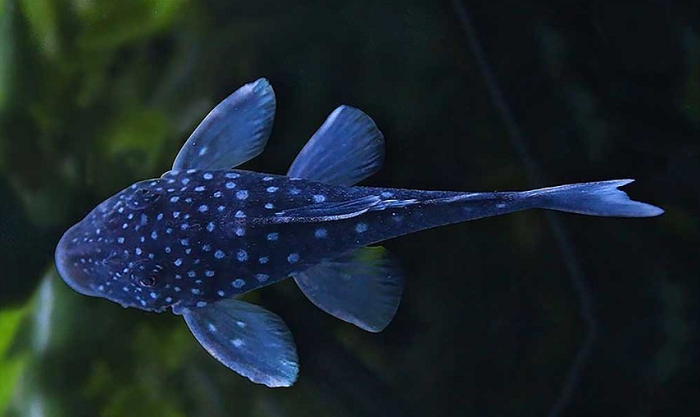
Firstly, keep in mind that the Blue Phantom Pleco is more adaptable to water conditions and temperatures, but not to sudden change. Thus, when you have established water conditions and temperatures, and properly cycled your tank, you will need to try and keep to these conditions.
Choosing A Pleco
Blue Phantom Plecos may be slightly harder to find, so you will need to do a bit of research on pet stores and breeders in your area that have them. They will mostly be caught, rather than bred in captivity because they are so difficult to breed.
When choosing a healthy Pleco, look for the following signs:
- Look for a rounded tummy that is not bloated, or has hollow areas.
- The Eyes need to be clear and bright with no white patches.
- Check the fins and body for damage or discoloration.
- There should be no white spots on the body and fins.
- The fish should have a healthy appetite.
How To Place A Fish In A Tank
Especially with a Pleco, you need some time to accustom them to water temperatures and water conditions.
- Allow the bag with your Pleco to float on the surface of the water for at least 30-40 minutes to acclimate.
- Replace a cup of water from the bag with water from the tank.
- Repeat step 2 with 15-minute intervals in between, until you have replaced most of the water in the bag.
- Place your fish in the tank, and try to avoid getting too much water from the bag in your tank.
Suitable Tank Mates
The Phantom Blue Pleco will get along with any fish species that are not the same. You can keep it with predatory fish, or Schooling fish of your choice, though I would avoid other catfish species. Keep in mind that the size and the water condition requirements of the tank companions need to be like that of your Pleco. If you are going to have a community tank, many fish keepers advise adding your Pleco last.
Feeding Blue Phantom Plecos
Blue Phantom Plecos are Herbivores ideally, according to trusted sources, though you may have heard that they have tendencies to feed on small crustaceans, invertebrates, and fish, which is true, but not essential to their diet.
Plecos feed mainly on Algae, because they are Xylophagous, and will feed on algae in your tank, if available. Plecos need the following food sources;
- Algae Wafers.
- Specialized Flakes and pellets.
- Fresh Vegetables such as Zucchini, Kale, Spinach, Cucumber, and courgettes, thinly sliced.
- Driftwood such as Bogwood and those mentioned in the tank décor.
Depending on the available number of algae in your tank, Plecos can be fed once every two to three days.
Tank Maintenance
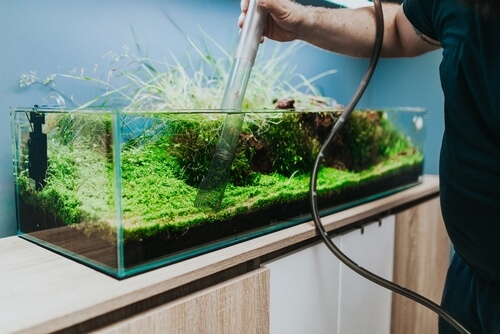
The Blue Phantom Pleco as an adult can be large, and generate a substantial amount of waste, thus weekly water changes and regular maintenance are required. It is important to remove visible waste and dead plant materials, or food, to prevent ammonia build-up in your tank.
You can follow these steps for a weekly water change:
- Tools Needed – A siphoning Hose, large separate container, water conditioners, heated water, or existing heater, testing Kit, Thermostat.
- Remove at least 255 – 30% of the tank water siphoning it from the bottom of the tank.
- Prepare the same amount of water in a second container that is the same temperature, or use your heater.
- Add water conditions to get the water to the right Ph levels and parameters.
- Use a testing kit and thermostat to test the water.
- Ensure that all parameters are the same as that in the tank.
- Now you can add fresh water.
Common Pests And Diseases In Phantom Plecos
The Blue Phantom Pleco is a healthy fish with few health concerns and a long life span. If water parameters and temperatures are kept constant, and your fish has minimal stress, then there would be no reason for concern.
However, there are a few common freshwater fish conditions that can similarly affect your Pleco:
- Ich
Ich is a parasite that will cause white spots on the body of your Pleco, followed by a loss of appetite, and lethargy. It can be treated by quarantining your fish to optimal water conditions and using medication from a vet or pet store for the condition. Many times the parasite is introduced by new fish or plants that have not been quarantined first.
- Dropsy
Though not very common in Plecos, it can still occur, where there is a bacterial, or fungal infection in the swim bladder (the organ that keeps fish afloat). Your fish may have difficulty keeping upright or swimming, though in many cases with Plecos, it is indigestion rather than Dropsy. Dropsy itself is treated with antibiotics and keeps water in optimal conditions.
- Fin Rot
In many cases, physical damage to the skin or fins of your Pleco can end up in an infection, usually because of poor water conditions. It leads to what we call Fin Rot, which deteriorates the fins, and eventually spreads all over the body. For this condition quarantine in clean water is needed, with regular water changes, and antibiotics.
- Digestive Issues
Plecos are more prone to digestive issues, and that is why we recommend healthy and clean Driftwood that is purchased, and not picked up for the fiber and natural bacteria. Plecos may suffer from bloating because of indigestion or have indented tummies, because of malnutrition, which means you may need to enhance their diet.
Breeding Blue Phantom Plecos
It is said to be close to impossible to successfully breed Blue Phantom Plecos, should you still want to follow through on this endeavor, you can try the following;
- You will need a separate tank with a sandy substrate and smooth rock structures that create caves, as your female Pleco lays her eggs in caves.
- While the Female spawns the male guards the cave
- The Female will lay 40 to 50 eggs, and can then be removed.
- The male will fertilize the eggs and guard them until they hatch.
- The eggs hatch in around 5-7 days and the eggs sac stays on for sustenance.
- Once the babies start becoming independent fry you can feed them baby brine shrimp.
Though these sites sound relatively easy, you will need a pair that has bonded from a young age and artificial hormones, which are mostly only available to a few elite professional breeders.
Final Thoughts
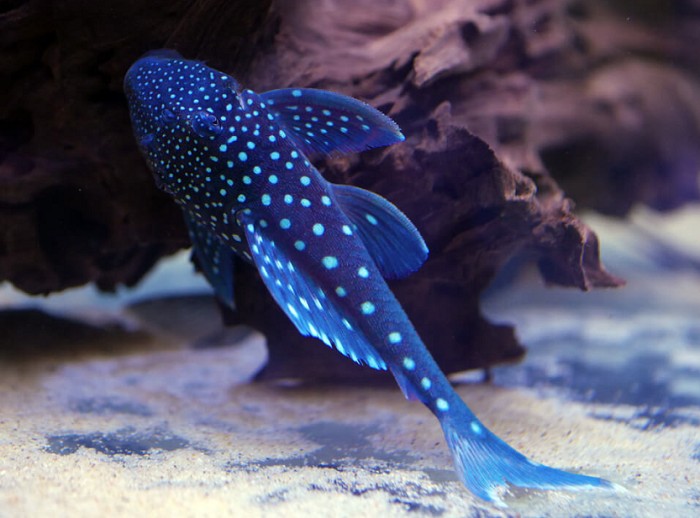
The Blue Phantom Pleco is a stunning morph of the Phantom Pleco that will brighten up your tank, with its deep and galactic-like colors. The peaceful nocturnal fish is easy to keep under constant water conditions and temperatures and will get along with any companion, except its kind, unfortunately.
As an algae eater, it has the added advantage of cleaning your tank, but the Phantom Pleco has additional dietary requirements. In addition, here are a few crucial facts, to sum up what we have gone through so far.
- The Phantom Pleco grows quite large in size and needs a sizable tank.
- It will not get along with the same species or other catfish, especially males when mature.
- Most Pleco breeds are hard, to impossible to breed, and the Blue Phantom Pleco is unfortunately not a fish to be bred in captivity.
- The Blue Phantom Pleco like most Pleco species needs driftwood for a balanced diet.
- It is adaptable but does not do well with abrupt temperature and water conditions changes.
- It is expensive, averaging from $30 to $120.


